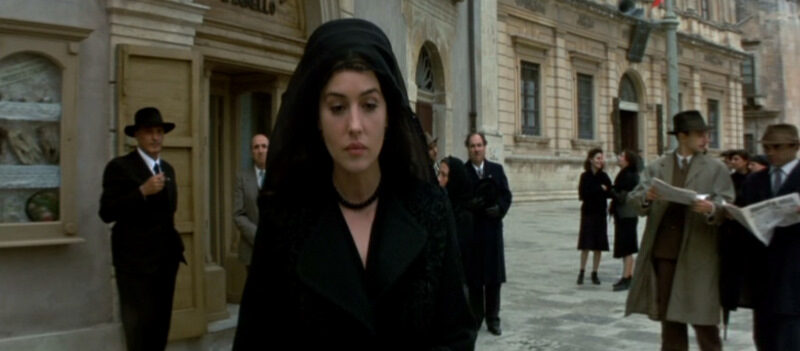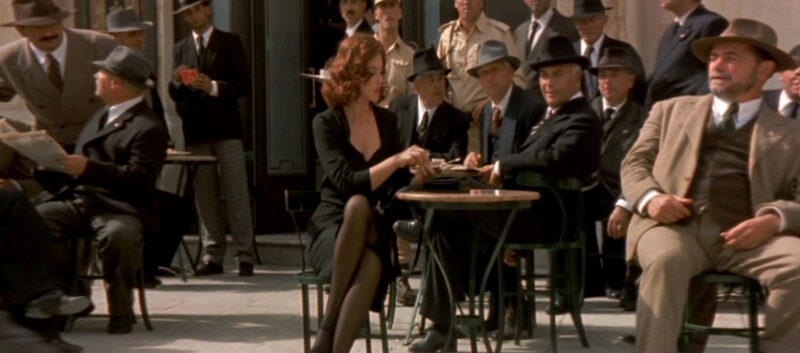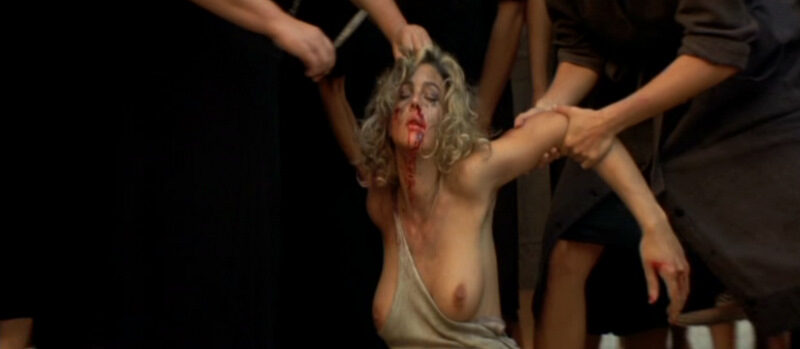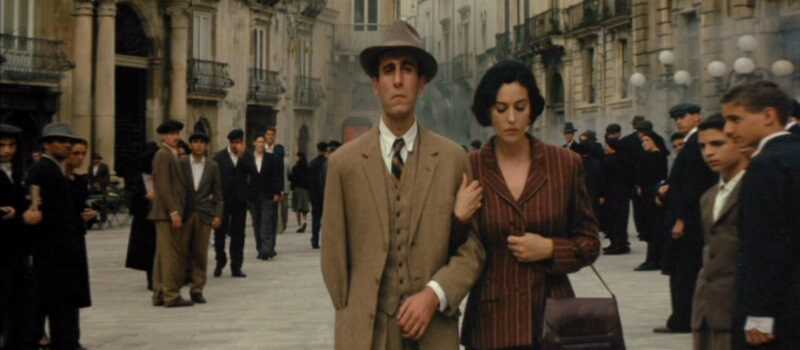Monica Bellucci as Malèna: Beauty, Black and Heels |
 © 2011, Clothes on Film 26 Aug ’11
© 2011, Clothes on Film 26 Aug ’11
In Malèna (2000, directed by Giuseppe Tornatore), set during WW2 in a rural Italian town, Monica Bellucci plays an impossible vision of beauty; a woman so striking she is immediately sexualised by all who lay eyes on her. Malèna’s reaction to the leering male gaze and subsequent scorn of jealous women is expressed through her hair, make-up and clothing.
Our introduction to the character occurs with Malèna wearing a just-below-the-knee white dress, lightly padded shoulders, deep neckline incorporating dotted bow detail (this fabric is later reused for another outfit – she is a seamstress) to match black and white edging on the revers. Its tubular fit is reminiscent of the form-fitting 1930s; Bellucci’s figure is emphasised within the story world, aligning our viewpoint with young protagonist Renato (Giuseppe Sulfaro) and not his leering friends. Renato sees Malèna as the perfect – the only – embodiment of woman. To cope with his infatuation, Renato fanaticises that he rescues and occasionally disciplines Malèna, yet knows this is impossible in real life until he comes of age.
The idea of expedited maturity is communicated via costume. Renato is so frantic to be perceived as a man away from short pants; a garment that evidently signifies childishness, that he sneaks his father’s best lounge suit to a tailor’s to have the trouser legs shortened. The change never occurs because his father discovers the misdeed then literally beats his son for daring to be so bold. Eventually Renato is fitted for a two piece suit, though it is his mother who supervises the tailor.
Malèna’s first transition is consequence of a vital plot point; she evolves from primarily black and white colour palette with some florals, and in Renato’s daydream a revealing pink lace trim nightgown, to pure black on realisation that her soldier husband had died while serving in Africa. Crucially Malèna remains in mourning, often with her head completely covered by a black chiffon scarf, until her second transition to prostitute for the occupying German army. Yet the black on black seems to draw even more attention to her apparent sexual availability.
Condemned as aloof and unfeeling by women and desperate to sexualise by men, Malèna is forced into submission; she becomes their lie. Even in court for indiscretions not yet undertaken, it is her angular silhouette of wide, padded shouldered crepe dress that lingers. Tornatore wants us to judge Malèna as they do; calculating and cold. Our viewpoint has been temporarily realigned. Even Renato struggles to keep faith.
Notably, Malèna is often shown to be wearing high heel slingback shoes. Colour and style vary, but that distinctive “click clack” sound remains. Aural warning of the temptress, it is almost as though Malèna marches through town like a Wild West gunslinger; she certainly evokes the same revulsion as one. Men have to dominate for fear of veiling their masculinity, while women must destroy what they perceive as a threat to their marriage.
Observe as Malèna steps from building to building trying to find respectable employment, camera peering up from her shoes to stocking seam to long dark hair blowing in the wind. Even with Renato as her would-be protector/voyeur, everywhere she goes Malèna is either ogled as a sex object or derided. For that town she was more deadly than the War.
When Malèna finally succumbs to bullying, partly due to poverty, partly by compulsion, she makes a third costume transition, which is perhaps the most important in narrative terms because although it only confirms what the townsfolk believe they already know, for Renato it forces him to grow up. Chopping her hair into a bob and dying it copper red, Monica Bellucci essentially portrays another character. With costume designer Maurizio Millenotti revealing her décolletage for the first time since the opening scene (unusually, with a zip fasten on the rear of her dress), Bellucci interprets Malèna as obviously terrified, yet as a rush of eager hands jut forward to light her cigarette, suddenly aware of her power too.
Her shocking red hair soon becomes Jean Harlow blonde. However, by this stage Malèna is too brazen. Despite her promiscuity, which is just what the local men thought they wanted, she has never looked less attractive. Now Malèna is a whore; conspicuous sexuality has overtaken mystique. When American troops arrive to liberate the town, she is brutally punished by an frenzied posse of wives for her collusion with the enemy.
In actual fact she is punished for simply daring to be. Malèna’s beauty did not enrage them; rather that she refused to deny it, so they took it away from her. Clean white dress ripped to expose her breasts, hair shorn and scalp bleeding; Malèna is hounded as a whipped dog. She flees on the next train out of town, veiled in black to hide her wounds.
After Malèna’s husband Nino (Gaetano Aronica) returns from Africa, evidently not dead but recovering from Malaria with a missing arm, he is treated almost as badly as she was, just for being married to her. Initially there is some measure of sympathy, but this soon gives way to name calling and even physical abuse. Thanks to Renato’s help, however, Nino does learn where Malèna has fled and a year later the couple return – together.
This is Malèna’s final transition, when she is at last accepted by the townsfolk. Not out of respect for her courage, but because in a brown striped utility suit, barely nipped in to hide her figure and low court shoes, she is no longer a threat. In essence, they won. They killed Malèna and she was reborn in their design; plain and anonymous.
© 2011 – 2012, Chris Laverty.










